- Zola vs MyRegistry: Which is the Best Registry for 2024? - November 30, 2023
- Best Art Deco Wedding Band Ideas - April 23, 2023
- Jade vs Emerald: Which Green Gemstone Is the One for You? - April 23, 2023
Blue gemstones are growing in their popularity. There are loads of different types to choose from across many different settings – from earrings and bracelets to engagement rings and eternity rings. Blue gemstones in jewelry crop up everywhere – and for a good reason: they’re gorgeous!
In light of that, we’re walking through some of the best blue gemstones used in jewelry making to give you a sense of what they are and what they’re made from. We’re also answering a few frequently asked questions about choosing the right bluestone for you!
Our Guide to the Best Blue Gemstones
There is lots to get through so let’s make a start.
But, first:
Why Blue?
It’s the color of the sky and the sea and is often associated with calm, positive wellbeing, and serenity. Much has been written about the meaning of different colors. But, where blue is concerned, it’s thought to represent loyalty, trust, and security. Additionally, it’s thought of as a conservative and safe color too.
Think of some of the most famous rings you’ve seen on the fingers of public figures: often, they’re blue.
Here we’re talking about Princess Diana and that famous blue sapphire in her engagement ring that The Duchess of Cambridge, Kate Middleton, subsequently wore. Going back, Napoleon bought Josephine, his bride-to-be, a gold ring with a single tear-shaped Sapphire and a pear-shaped diamond.
Fast forward, and while their engagement didn’t work out, cricketer Shane Ward presented model, actress, and fashion designer Elizabeth Hurley with a 9-carat blue Sapphire with a diamond on each side.
Clearly, blue gemstones boast a rich history and are a popular choice among celebrities and royalty alike. That said, let’s check out some of the different blue gems available:
Blue Diamond
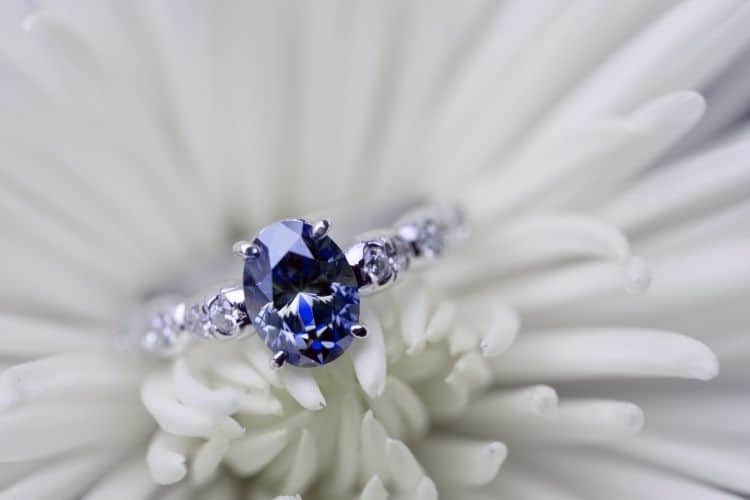
Let’s start with the king of all stones, the diamond. Unlike their white or clear counterparts, blue diamonds are super rare. That’s why they’re so expensive. However, there are more affordable synthetic alternatives out there for the budget-conscious bride.
But, back to the natural kind, blue diamonds are blue because of their formation. A mineral called boron gives them their distinctive and regal tone. It is common with other blue gemstones, you can get different shades of blue diamond.
One of the most famous blue diamonds is called the Hope diamond, which has a very high boron concentration and weighs 45.52 carats. If you’re ever in Washington, you can see it at the Smithsonian Institute in DC. Be under no illusion; blue diamonds are tough. They have an impressive hardness score of 10. That said, they can still break if hit super hard.
Blue Sapphire
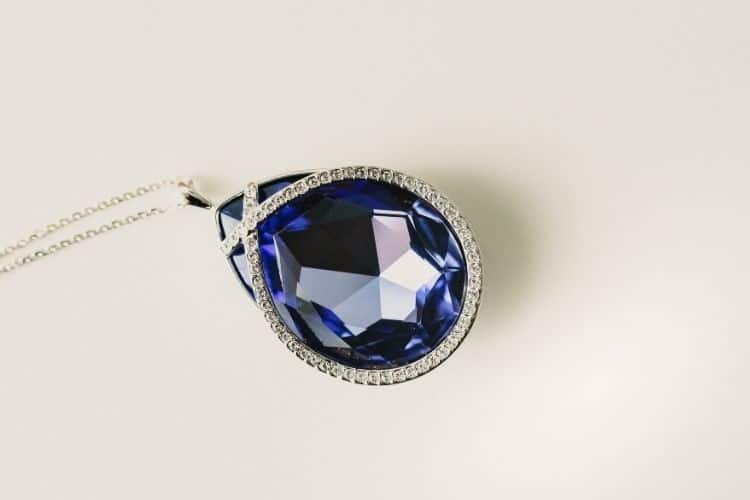
We’ve already nodded towards the blue sapphire earlier in our review. It’s a very popular gemstone and has never really gone out of fashion. Sapphire is a precious gemstone and comprises various minerals called corundum and traces of iron, aluminum oxide, titanium, magnesium, and chromium.
Typically we tend to associate blue sapphires with engagement rings. Like diamonds, blue sapphires are pricey but not as expensive. Similarly, you can acquire replicas or synthetic lab-grown versions, which are much cheaper by comparison.
Sapphires are almost as hard as diamonds, with a hardness score of 9. As such, they’re unlikely to chip or break.
Aside from the famous sapphires we’ve already referred to, let’s not forget the beauty worn by Mary Pickford. The silent movie star was given The Star of Bombay sapphire by her husband, Douglas Fairbanks. When she died, it was donated to the Smithsonian Institute.
If you’re a gin fan, you might be interested to know that this stone is where Bombay Sapphire gin got its name from!
Blue Zircon
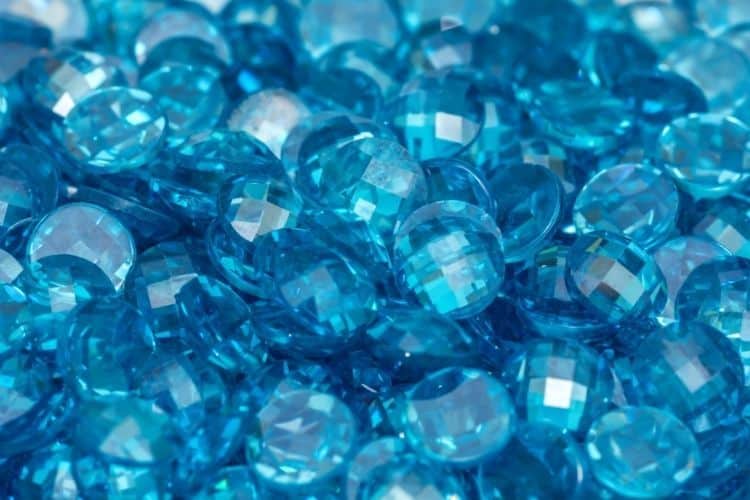
Next on our list of best blue gemstones is blue zircon (AKA Starlite). Blue Zircon is sometimes compared to the blue diamond, but the similarity ends there. Blue zircons are near-on as sparkly as diamonds, but they’re softer, with a hardness score between 6 to 7.5 on the Mohs scale. This means the stone can be a bit brittle. As such, it’s easier to chip; making it essential to take extra gentle care when cleaning it.
Other than blue, zircon comes in a range of colors, including brown, yellow, orange, green, and clear. It’s found in Australia, Sri Lanka, Cambodia, and Thailand.
Interestingly, it’s the oldest mineral found on earth, dating back 4.4 million years. The oldest blue zircon was found in metamorphosed sandstone in the Jack Hills of the Narryer Gneiss Terrane in Western Australia. Historically, Blue zircon was seen as a valuable stone and a sign of luxury.
It’s actually attributed to Pluto’s planet and said to promote prosperity, rest, and sleep. During the 19th and 20th centuries, one of its most prominent and better-known fans was Tiffany’s famous chief gemologist, George Kunz. It was also popular among the Victorians.
Fast forward to today, and unfortunately, zircon is often confused with the cheaper and less valuable man-made stone, cubic zirconia. In other words, it sometimes gets an undeserved hard rap.
Aquamarine
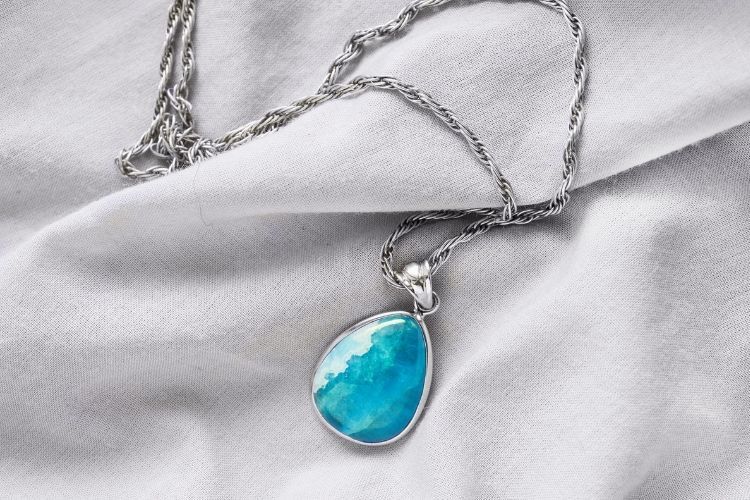
When we think of this cool, light bluestone, we immediately conjure thoughts of crystal blue waters. Therefore, it should be no surprise that this stone’s name comes from the Latin for seawater.
Said to create a sense of calm and happiness, the Ancient Greeks wore aquamarine. They believed that it represented the sea’s spirit. It was thought to give the wearer courage in earlier times – for example, the Ancient Egyptians wore it in talismans.
Similarly, the Ancient Indians wore it in amulets. In the Middle Ages, aquamarine was said to promise wearers a happy marriage with fidelity.
Aquamarine has a good hardness score of between 7.5 to 8 and boasts excellent clarity. It’s often set in rings, necklaces, or earrings, and it has good durability. As a member of the Beryl family, it’s primarily mined in Brazil.
While often seen as a pale blue stone, its color spectrum is somewhat broader, with rocks ranging from pale to deep blue to blue-green.
Aquamarine also has a long-standing relationship with the rich and famous. In fact, the UK’s Queen Elizabeth had a tiara showcasing the stone, commissioned to match a pair of earrings and a necklace she received from the Brazilian president in 1953.
Fast forward a little, and we saw Justin Timberlake present Jessica Biel with a 6-carat aquamarine engagement ring.
Blue Topaz
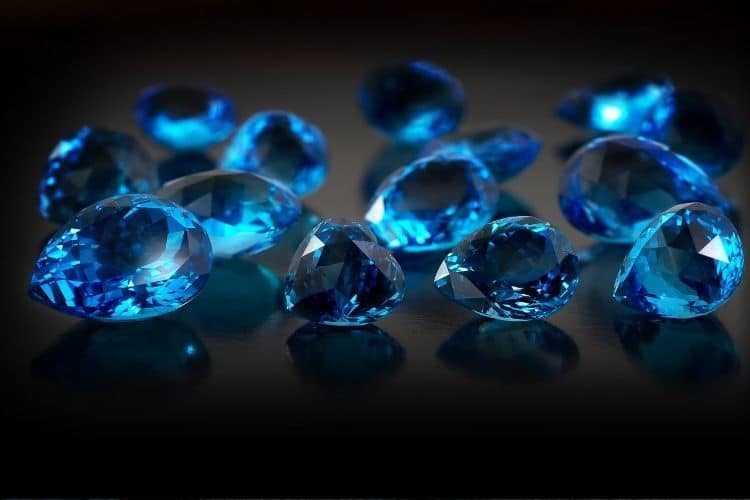
One of the more affordable blue gemstones on this list is blue topaz. This is a heat-treated stone that comes in lots of different types. The most expensive of which are London Blue, Swiss Blue, and Sierra Blue.
Interestingly, blue topaz is heat-treated to achieve the blue color as the stone is actually clear. The Mohs scale gives it an 8 for hardness, and it’s mined right around the world, including Brazil, Sri Lanka, China, Mexico, Russia, and the USA.
Blue topaz is said to represent healing and peace. The Romans are responsible both for discovering and naming it. It was found two millennia ago on the island of Topazia, which sits in the Red Sea. The Romans believed the stone could protect them from their enemies.
However, it wasn’t just the Romans who attributed meaning to this deep blue stone. The Ancient Egyptians believed it had mystical powers from Ra, the Sun-god. Furthermore, some South American tribes thought blue topaz could promote healing when the moon was full.
The largest blue topaz in the world is the Marbella Topaz, weighing a whopping 8,225 carats! Perhaps the most famous wearer of this blue stone is The Duchess of Cambridge, who has a pair of Blue Topaz and diamond drop earrings.
Turquoise
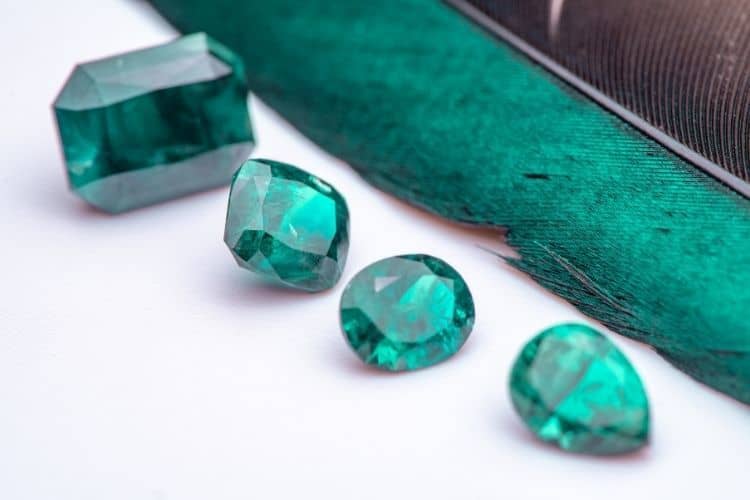
No blue gemstone review is complete without a nod to this unique stone. Unlike the other stones in this review, turquoise isn’t transparent; it’s opaque. Often you can see a stone matrix with vein-like threads that are often present in turquoise.
Commonly seen in the jewelry of all kinds, especially earrings and necklaces, turquoise is a popular stone because it’s affordable. Available in a range of colors from sky blue to blue-green and even pale green. The color is determined by the amount of copper and iron found in the stone.
It has a Mohs hardness score of 6 and is quite porous, making it more likely to break than other blue gemstones. That said, this stone has been around a long time. It was one of the first gems to be mined, dating back to the Ancient Egyptians and 6000BC. It’s also been mined in Iran for 3,000 years.
Tanzanite
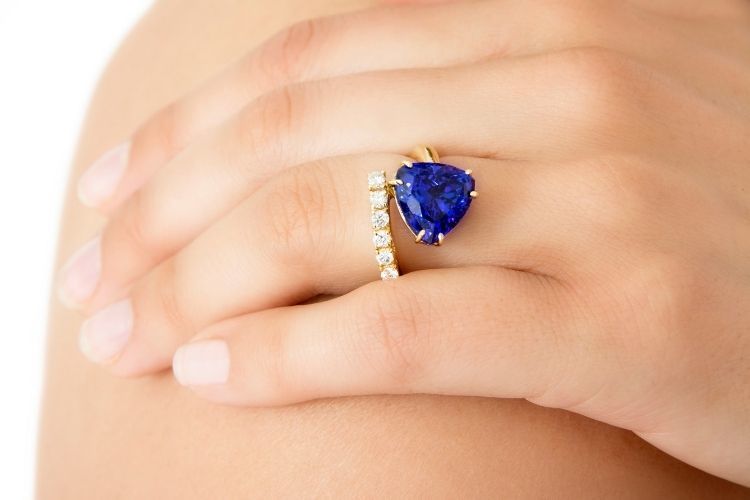
Named after the country in which it was found (Tanzania), Tanzanite is extremely rare. It has a deep blue/purple/indigo mix that’s unrivaled. Although it’s actually brown in its natural form, its color comes after its heat treatment.
One of the stone’s most significant ever finds was in 2020, when a small-scale miner in Tanzania found two large lumps of the rock, with a combined weight of 15kg. Saniniu Lazer became an overnight millionaire earning $3.4m. He told reporters that he planned to invest the money in building a school and a shopping mall for his community.
Tanzanite is often used to make ornaments rather than jewelry, although there are some notable exceptions to this. Actress Cate Blanchett wore a Blue Tanzanite necklace at the 2012 Cannes Film Festival. Also spotted wearing the stone was Beyonce, who was snapped wearing a Tanzanite ring.
Blue Tanzanite has a Mohs reading of 6.5 and can be pretty brittle. It’s often gifted to celebrate 24th wedding anniversaries – so bear that in mind if you’re in the market for a 24th wedding anniversary gift!
FAQs about the Best Blue Gemstones
Answer: We’re keeping things general here because when investing in any kind of gemstone, blue or otherwise, the seller should give precise advice on keeping it in good condition.
But, generally speaking, the most important thing to remember when cleaning your blue gemstone is to do it gently. Don’t use abrasive cleaning fluids or rough sponges. Instead, warm soapy water and a soft cloth will do.
That said, the more porous the stone, the less contact it should have with water. When cleaning a porous stone, just use a damp cloth and dry it once you’re finished.
For more information, The Gem Society has a helpful and concise guide to gemstone cleaning that you may find beneficial.
Answer: The blue gemstones in our review aren’t the only ones out there; we just focused on some of our favorites. If you’re interested in exploring blue gems further, there are plenty to choose from.
Here’s just a few more notable blue gemstones:
Blue Garnet: A rare and recent addition to the gemstone world. Typically red, blue garnets arrived on the scene in 1998 after being discovered in southern Madagascar’s mines. They change color depending on the light and have a hardness of 6.5 to 7.
Blue Tourmaline: There are two types – Indicolite and Paraiba. The former comes in shades ranging from light to dark blue, while the latter is a vivid blue. The stone has a Mohs hardness of 7 to 7.5 and is very rare.
Blue Iolite: A popular and affordable gemstone whose color varies from light to dark blue. It’s not a rare stone, making it an affordable option. It has a hardness of 7 to 7.5.
The rocks aren’t enhanced or treated and often mined in Sri Lanka, Brazil, Myanmar, India, and Brazil. The higher quality types of Iolite can sometimes be compared to Sapphires.
Answer: Again, we’re keeping it general here because different gemstones have different qualities. However, here’s our list of questions to ask your gemstone dealer before committing to a sale:
Where does this particular gemstone originate from? This is important because you want to know where your retailer sources their stones and if their suppliers are reputable.
Has this stone been treated? Many blue gemstones are heat treated to enhance their color, and we’ve referred to this in our review. However, it’s always worth asking this question to test the knowledge of your retailer. Also, sometimes treating a stone can impact its durability.
So it’s always worth knowing as much as you can about where its color came from if you know it didn’t come naturally.
Can you tell me about the stone’s cut, clarity, carat, and color? Commonly referred to as the 4Cs in the gemstone world, these are the barometer by which a gemstone’s quality is determined.
Answer: The beauty of the gemstone world is that there’s something out there for everyone. If sapphires and diamonds aren’t an option for you, here are a few more affordable man-made options:
Synthetic blue sapphire: Often used because they resemble the real thing, these have been around since the early 1900s. They’re also called synthetic corundum. They’re lab-created using a flame fusion method and can come in as little as $100 for a stone.
Synthetic blue cubic zirconia: Often a popular diamond alternative, it’s also bought as a substitute for aquamarine and other blue gemstones. Sometimes they’re referred to as cultured diamonds or simulated diamonds. They’re created by melting powdered zirconium dioxide with magnesium and calcium.
Synthetic forsterite: This is generally considered a tanzanite substitute. It’s possible to acquire natural versions of this stone, but it’s unsuitable for cutting into rocks. The man-made version comes from Russia.
Best Blue Gemstones – Final Thoughts
So there you have it, our guide to the best blue gemstones in jewelry. It’s clear that there are tons of blue gems out there to choose from, so depending on the type of jewelry you’re hoping to buy, there’s sure to be something that suits your tastes and budget.
The most important thing to remember aside from your budget is to ask questions about the stone. You’ll also want to be sure of what you want the stone for, i.e., an engagement ring/necklace/earrings, etc because you’ll want to pick a stone that will stand the test of time.
Lastly, always ensure your chosen retailer has a good reputation and transparent returns and after-sales policies. That’s it from us; let us know how you get on in the comments box below; we’d love to hear from you!
